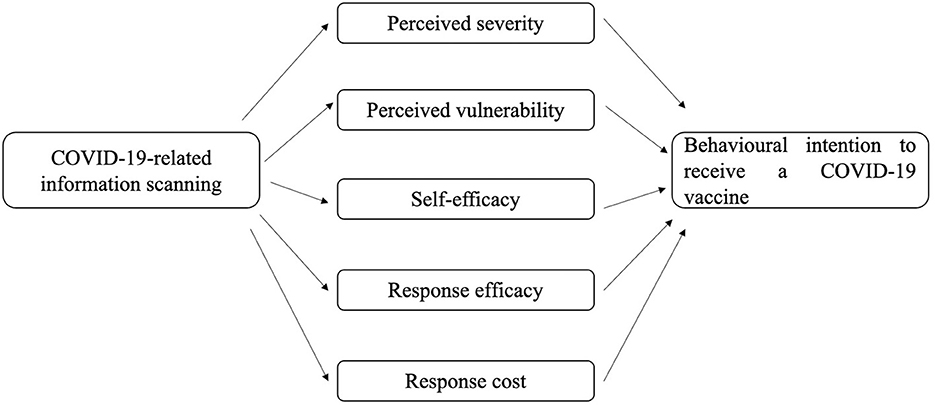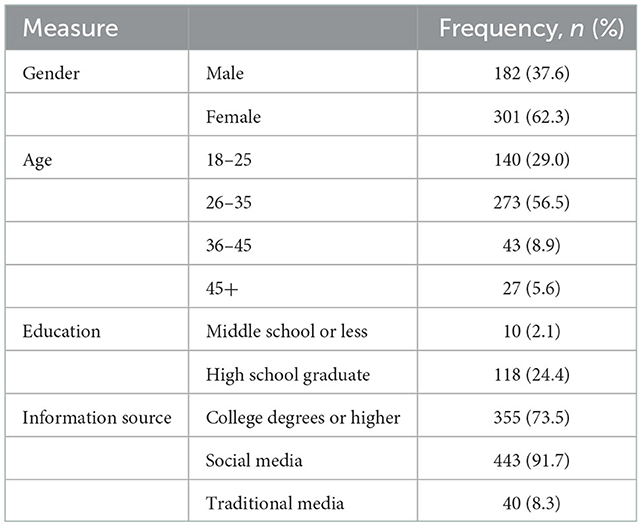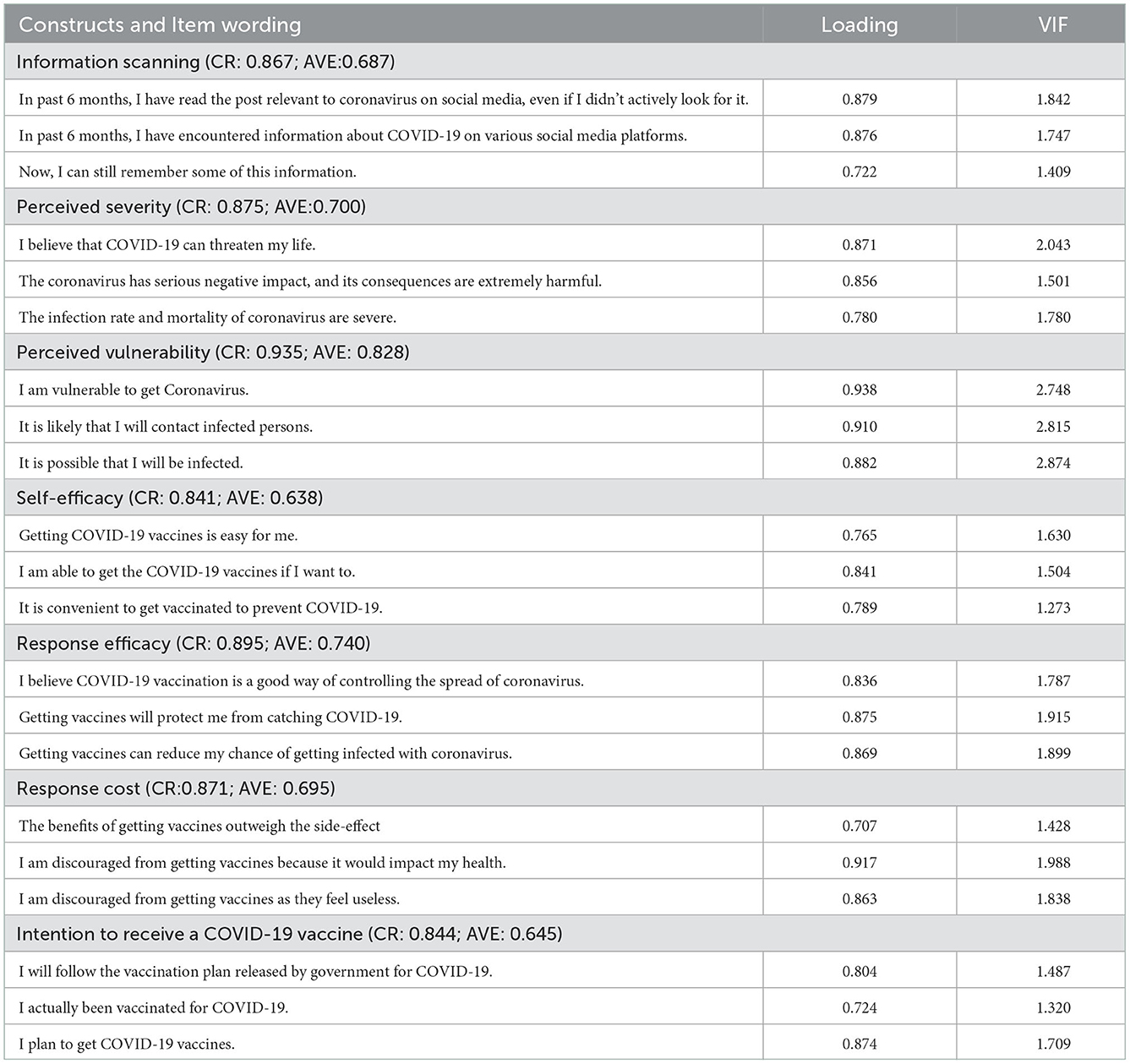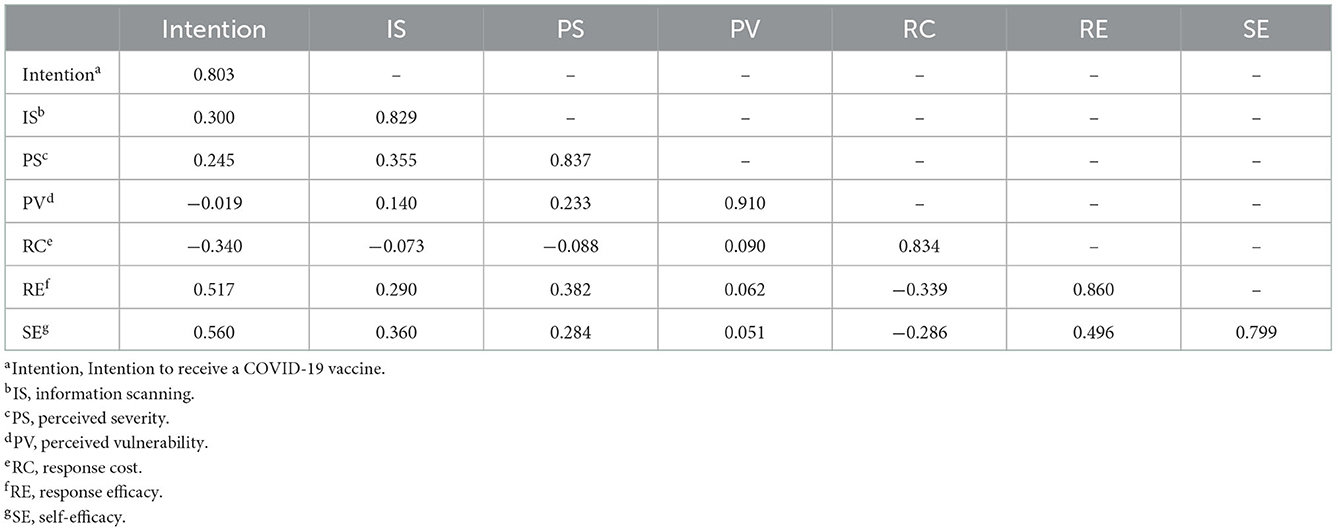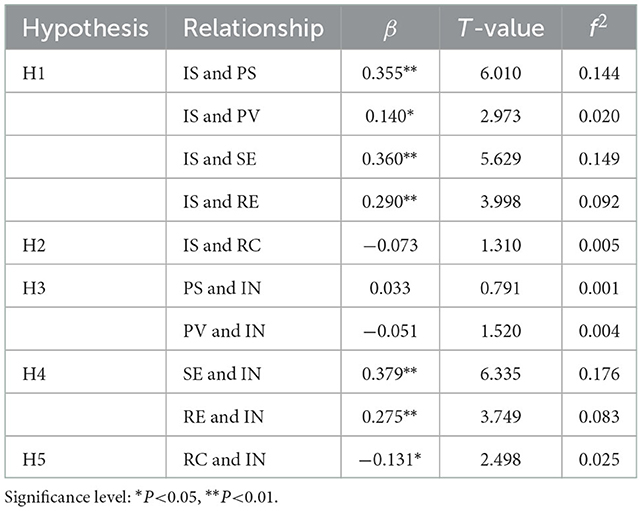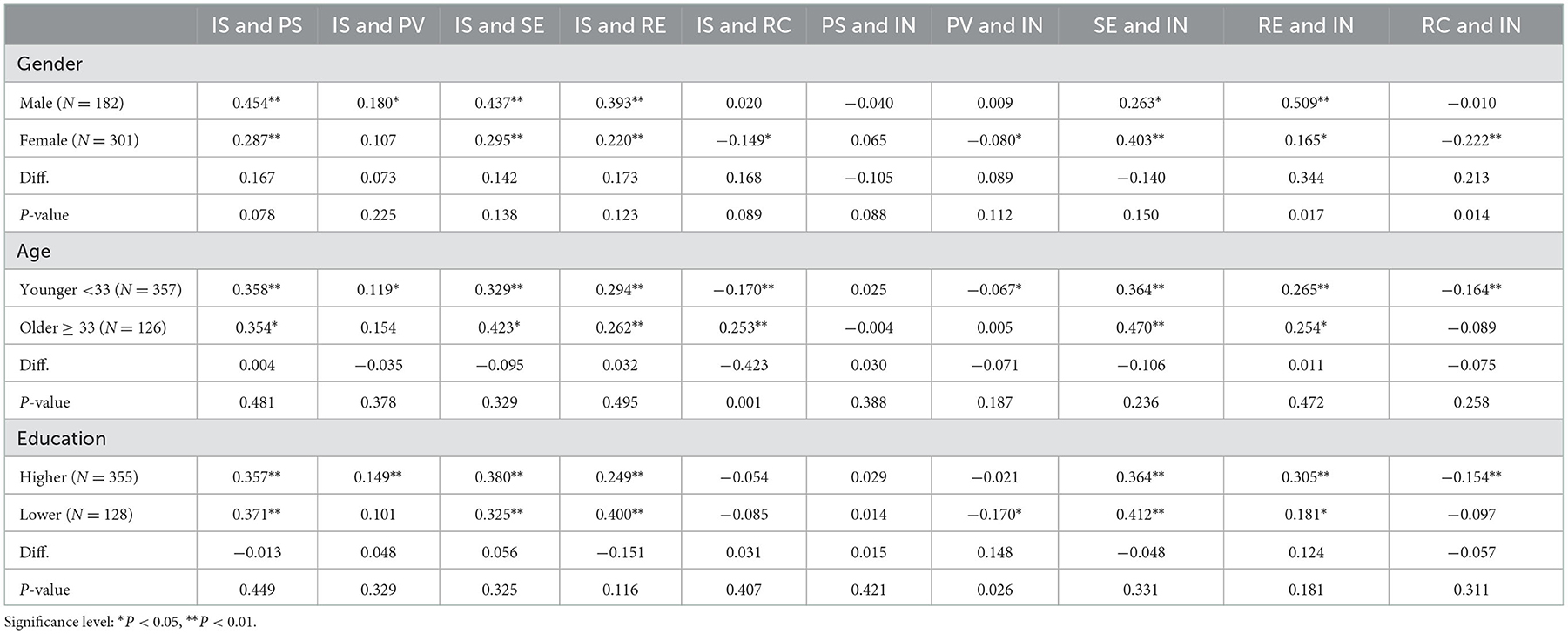The impact of COVID-19-related information scanning via social media on Chinese intentions regarding coronavirus vaccinations
- School of Sociology and Public Policy, University Institute of Lisbon, Lisbon, Portugal
Background: During the COVID-19 health crisis, there is a recognized need for addressing vaccine hesitancy to increase vaccination rates globally. In this context, exploring the underlying public behavioral mechanism related to COVID-19 vaccine decisions has been the focus of much investigation.
Objective: This thesis seeks to investigate and explain the impact of COVID-19-related information scanning via social media on health perceptions and behavioral intentions to receive COVID-19 vaccine doses in China.
Methods: By distributing a questionnaire online, 483 respondents were recruited. Then, the present study applied partial least squares structural equation modeling (PLS-SEM) by using Smart PLS 3.3. Finally, the variance of path relationships among different socio-demographic groups was tested by performing multigroup analysis.
Results: COVID-19 information scanning via social media has positive influence on four constructs, including perceived severity (β = 0.355, p < 0.01), perceived vulnerability (β = 0.140, p < 0.05), self-efficacy (β = 0.360, p < 0.01) and response efficacy (β = 0.355, p < 0.01). No significant correlation was found between threat appraisal and behavioral intentions to get vaccinated, including perceived severity and perceived vulnerability. And scanned information exerts influence through other significant factors, including self-efficacy (β = 0.379, p < 0.01), response efficacy (β = 0.275, p < 0.01) and response cost (β = −0.131, p < 0.05). Additionally, response efficacy exerts stronger influences on men's behavioral intentions, whereas response cost and perceived vulnerability are stronger mediators among women. Surprisingly, scanned information is positively associated with response cost among older adults, and perceived vulnerability was negatively associated with behavioral intentions to receive the coronavirus vaccines among younger adults. And there were significant differences in the association of perceived vulnerability and behavioral intentions between lower and higher educated groups.
Conclusion: The present results highlight the key roles of COVID-19-related scanned information on public health perceptions and behavioral intentions. Tailored health communication must deliver factual information, address the public uncertainty regarding adverse effect of COVID-19 vaccine, and clarify vaccine schedules.
1. Introduction
Since the World Health Organization announced Coronavirus disease (COVID-19) as a global pandemic in March 2020, it has caused unforeseen setbacks in social and economic development, as well as in people's livelihood. By June 2021 (when the present survey began), officials had recorded over 170 million confirmed cases and 3 million deaths all over the world. Given the continuing growth of infection cases and deaths, COVID-19 vaccination has been recognized as one of the effective ways to overcome the current health crisis (Coe et al., 2022). As of September 2021, the total number of COVID-19 vaccine doses administered had reached over 5 billion in the world, with 878.52 million in China. As societies are relying on COVID-19 vaccinations to contain the pandemic, there is an urgent need to increase levels of vaccine acceptance (Lindholt et al., 2021). In the literature, vaccine hesitancy is generally understood to mean individuals' anti-vaccination sentiments that refer to hesitancy, refusal, or delay in acceptance, and has been widely acknowledged as being a primer barrier to the success of vaccination programs (MacDonald, 2015).
According to Digital China 2021, given the rapid development of mobile media technologies, social media has become more advanced communication tools and primary information sources and there has been a remarkable rise in the number of social media users in China, reaching around one billion by 2021 (DataReportal, 2021). Notably, in the last few decades, there has been a surge of interest in the impact of social media not only on delivering greater diversity of health information, but also combating vaccination hesitancy during the health crisis (Khan et al., 2020; Tran et al., 2020). In this regard, social media has been widely utilized by Chinese netizens and authorities to disseminate COVID-19-related information and exchange opinions in a timely manner (Luo et al., 2021). For instance, extant studies have revealed that the Chinese relied more heavily on social media platforms to engage in online activities during the physical social isolation and unprecedented lockdowns, such as posting, searching for disease knowledge and precautionary measures, and commenting (Li and Liu, 2020). Prior studies have demonstrated that the large increases in these purposeful activities on social media platforms can contribute to fulfilling public information and emotional needs, mitigating anxiety and reducing uncertainty (Zhao et al., 2020). In contrast, other studies have concluded that the false information, misconceptions, and personal negative experiences posted across social media contribute to vaccine hesitancy and refusal (Arede et al., 2019). Compared to information seeking, information scanning is more focused on comparatively unintentional or incidental information exposure that can be considered as a spontaneous consequence of daily life (Lewis, 2017). In prior studies, information scanning is defined as routine information acquisition that can be recalled in a later time (Niederdeppe et al., 2007). As more and more individuals are increasingly likely to obtain health information through digital media rather than consult with medical professionals, this highlights the need for efforts to explore the influence of information scanning via social media platforms on public vaccine acceptance (Qiao et al., 2020).
In the literature, several researchers have utilized theories of health behavior models to explore predictors of public intent to receive the coronavirus vaccines. At its core, it has been noted that individual's health beliefs are recognized as key preconditions for actual self-protective behaviors, such as perceived benefits, perceived susceptibility, and self-efficacy (Wong et al., 2020; Machida et al., 2021). Additionally, previous findings heightened an urgent need to understand the decisive mediators existing between communication behaviors on social media and health behavioral intentions. However, what is not yet known is how screening information acquisition regarding COVID-19 via social media may interact with public intentions to engage with COVID-19 vaccination. Hence, it is necessary to explore the reasons behind public protective behavior intentions, that will contribute to addressing vaccine hesitancy, as well as boost COVID-19 vaccine uptake.
To address these knowledge gaps, the purpose of this study was to ascertain the relationship between information scanning via social media and COVID-19 vaccine acceptance among people in China. Likewise, this study seeks to assess the extent to which influencing factors relate to the public intentions to receive COVID-19 vaccines. Taken together, understanding the link mentioned above will provide new insights into social-media based health communication regarding COVID-19 vaccination promotion.
2. Research model and hypothesis
The present theoretical model was established based on the protection motivation theory (PMT). In the literature on the subject, PMT has become one of the most prevalent theories to explain individuals' underlying behavioral mechanism and predict their adoption of containment measures during pandemics (Xiao et al., 2014). According to Rogers and Prentice-Dunn (1997), it comprises two main constructs that impact intention for self-protective behaviors. The first refers to threat appraisal that includes an individual's beliefs of the severity (perceived severity) and their estimation of the likelihood of infection (perceived vulnerability). The second refers to coping appraisal that includes an individual's evaluation of their own capability (self-efficacy), efforts to execute recommended behavior (response cost), and efficacy of protective measures (response efficacy) (Rad et al., 2021). Figure 1 shows the theoretical framework explaining the relationship of information scanning, health perceptions, and behavioral intention.
In fact, obtaining health information via scanning has become more frequent than via seeking which provides more opportunities to promote both health literacy and better health behaviors (Niederdeppe et al., 2007; Moran et al., 2016). It has been conclusively shown that increased level of knowledge can contribute to a clearer understanding of the current situation (Bowles et al., 2020). Furthermore, the relevant literature has emphasized the importance of propagating specific health knowledge on preventing uncertainty, increasing public awareness as well as enhancing public engagement during the health emergency (Zhong et al., 2020; Paul et al., 2021). Accordingly, the following hypotheses were proposed:
H1: COVID-related information scanning is positively associated with perceived severity, perceived vulnerability, self-efficacy, and response-efficacy.
H2: COVID-related information scanning is negatively correlated to response cost.
According to previous studies, an individual's decision to vaccinate depends on their perception of the risk and seriousness of the corresponding situation. In this regard, for instance, recent studies have shown that perceived risk and perceived susceptibility are the strongest determinants of behavioral intention (Shmueli, 2021; Coe et al., 2022). Furthermore, existing findings have demonstrated that the people who have higher self and response efficacy are more likely to perform protective behaviors (Brouwer-Goossensen et al., 2016; Lin et al., 2020). In contrast, previous studies have found that response cost exerts negative influence on health intention (Farooq et al., 2020). On the basis of existing findings, the hypotheses that will be tested are as follows:
H3: An individual's perceived risk and perceived susceptibility of infection positively correlate with intention to receive a COVID-19 vaccine.
H4: Self-efficacy and response efficacy have positive influence on public intention to receive a COVID-19 vaccine.
H5: Response cost is negatively associated with increased protective behavioral intention.
3. Methods
3.1. Data collection
All data was collected by using an anonymous self-administered questionnaire. The questionnaire is composed of four sections, including sociodemographic factors, COVID-19-related information scanning behaviors, health beliefs and final behavioral intention. To ensure it is understandable and accessible, the questionnaire was translated into Chinese by two researchers whose native language is Chinese. In the current study, the participants were recruited through the Credamo platform (https://www.credamo.com/). And meanwhile, the QR code and link of the questionnaire also were distributed through three popular social media platforms: WeChat, Sina-microblog, and QQ. The primary selection criteria of participants focused on Chinese social media users who were 18 years of age or older. The other inclusion criteria required participants to be eligible for the COVID-19 vaccine. The methodology and questionnaire for this study were approved by the Ethics Committee of ISCTE—Lisbon University Institute (Code:109/2021). Of the study population, 483 subjects completed and returned questionnaire, and the respondents' demographic profile was summarized in Table 1.
3.2. Measurement items
The wording of all constructs related to the present analyses is displayed in Table 2, all decisions on indicator set-up were based on previous studies. Regarding COVID-19-related information scanning, there was a three-dimensional measurement, including activeness, breadth (the total number of information sources) and depth (the degree to which participants recalled) (Niederdeppe et al., 2007). Hence, in this regard, three questions were adopted, and responses were given on a 5-point Likert scale (1 = completely no to 5 = completely yes).
Regarding COVID-19 risk perception, this was measured by three questions on respondents' beliefs concerning the severity of the coronavirus, and three other questions on their recognitions of susceptibility to the virus (De Coninck et al., 2020; Coe et al., 2022). Likewise, we used three self-report items to assess whether participants felt capable of vaccine uptake (Chu and Liu, 2021). Similarly, multi-item scales were adopted to measure response efficacy and response cost (Farooq et al., 2020). All responses ranged along on a 5-ponint scale (1 = strongly disagree to 5 = strongly agree). Furthermore, participants were asked to illustrate their intentions to accept a COVID-19 vaccine on a 5-point scale, (ranging from 1 = very unlikely to 5 = very likely) (Lin et al., 2020; Shmueli, 2021).
3.3. Statistical analysis
In present exploratory studies, data entry and preliminary analysis were carried out using SPSS, version 26. Following this, to evaluate hypothesized model and explore the relationship between variables, partial least squares structural equation modeling (PLS-SEM) was performed using Smart PLS 3.3. This method is considered as one of the more powerful ways to test proposed research model as it has greater flexibility to analyze small samples and different types of data. Next, the multi-group analysis was conducted in order to quantitively describe the differences in path coefficients among socio-demographic groups.
4. Results
4.1. Measurement model
To evaluate how well constructs are assessed by their measurement items, both reliability and validity have been examined. In accordance with previous studies, outer loadings of the reflective constructs and composite reliability were tested to assess reliability, whereas convergent validity was assessed using average variance explained (AVE) (Fornell and Larcker, 1981; Hair et al., 2014). Besides this, discriminant validity was examined based on Fornell-Larcker criterion and the variance inflation factors (VIF) was also measured to assess the multicollinearity between indicators (Sarstedt et al., 2017). As can be seen in Table 2, all factor loadings and the value of CR satisfied the recommended threshold value of 0.7, and the value of AVE is above the threshold of 0.5 as well (Hair et al., 2014; Valls Martínez and Martín Cervantes, 2021). In addition, VIF is lower 5, suggesting acceptable multicollinearity. Moreover, the results obtained from Table 3 indicate the model met criterions (Wong, 2013). Consequently, we ascertained the reliability, validity and internal consistence of this model.
4.2. Hypotheses testing
By running PLS bootstrapping with 5,000 subsamples, this model explained 40.8% of the variation in behavioral intentions to get COVID-19 vaccinations. And according to prior studies, an effect size was identified by f2, with higher than 0.02, 0.15, and 0.5 is low, medium and large respectively (Ringle et al., 2015).
From the Table 4, the result shows that COVID-19-related information scanning had a statistically positive association with perceived severity (β = 0.355, P < 0.01), perceived vulnerability (β = 0.140, P < 0.05), self-efficacy (β = 0.360, P < 0.01) and response efficacy (β = 0.355, P < 0.01). Contrary to expectation in H2, information scanning was not found to affect response cost significantly. Furthermore, it has been noted that neither perceived severity nor perceived vulnerability has significant effects on behavioral intentions, whereas both self-efficacy (β = 0.379, P < 0.01) and response efficacy (β = 0.275, P < 0.01) were significantly correlated with ultimate behavioral intentions. As postulated, response cost exerts negative influence on behavioral intentions to get COVID-19 vaccinations (β = −0.131, P < 0.05).
4.3. Post-hoc analysis
In the measurement invariance of composite model procedure (MICOM), the partial measurement invariance was established, then, a Multi-Group Analysis (MGA) was carried out to explore whether there were significant differences in path coefficients between different socio-demographic groups, including genders (male vs. female), ages (younger vs. older) and education level (lower vs. higher). Here, in this regard, a P-value lower than 0.05 or higher than 0.95 indicates significant differences in the group (Cheah et al., 2020).
As can be seen in Table 5, the influence of anti-smoking-themed information scanning on perceived severity, self-efficacy and response efficacy was supported across all the groups. Similarly, the relationship of intentions to get vaccinated with self-efficacy and response efficacy was also confirmed for all the groups. And the hypothesis which proposed perceived severity positively influences intentions was not supported in any of the groups. Additionally, the association between information scanning and perceived vulnerability was only supported for the male, younger and higher educated group. Moreover, the effect of perceived vulnerability on intentions was confirmed among the female, younger, and lower educated group. Furthermore, the response cost significantly affected intentions to get vaccinated for female, younger people and users with higher education level.
It is notable that no significant differences among these groups in most of the relationships were evident. However, differences were observed between male and female participants in that response efficacy exerts stronger influences on men's behavioral intentions to receive COVID-19 vaccine doses (difference = 0.344, P < 0.05), whereas the effect of response cost on ultimate intentions is much stronger among women (difference = 0.213, P < 0.05). Besides this, a statistically significant correlation was found between COVID-19-related information scanning and response cost for women (β = −0.149, P < 0.01) and younger participants (β = −0.170, P < 0.01). Surprisingly, there was a positive association between information scanning and response cost in elder group (β = 0.253, P < 0.01).
5. Discussion
The present paper aims to establish the influence of COVID-19 information scanning via social media and identify behavioral determinants influencing COVID-19 vaccine acceptance among Chinese social media users. Consistent with the literature, seven out of ten hypothesized relationships were proved: exposure to COVID-19-related information through diverse social media channels was significantly associated with four mediators, involving perceived severity, perceived vulnerability, self-efficacy and response efficacy. These results may be taken to indicate the importance of being knowledgeable about COVID-19 vaccinations in increasing health perceptions as well as promoting willingness to accept a COVID-19 vaccine (Lazarus et al., 2021). In other words, the people with higher health knowledge are more accepting of vaccination (Logan et al., 2018; Ruiz and Bell, 2021). Notably, in this regard, recent studies have highlighted the urgent need to deliver clear and relevant health information that balance publishing frequency of content regarding the benefits and risk of COVID-19 vaccination (Vulpe and Rughiniş, 2021).
In accordance with the present results, prior studies have also pointed out the significant relationship between three constructs (self-efficacy, response efficacy, and response cost) and behavioral intention to receive a COVID-19 vaccine (Ansari-Moghaddam et al., 2021; Kalam, 2021). Hence, these findings are indicative that vaccine attitude and COVID-19-related beliefs were good preconditioners of intention to get the vaccination. Notably, self-efficacy was found to be a stronger predictor for behavioral intentions than any other constructs (Eberhardt and Ling, 2021). Clearly, the results highlight the importance of safety, effectiveness, availability, and conveniences for COVID-19 vaccination to improve community engagement (González-Block et al., 2020). Therefore, effective health communication across different channels requires the clarification of the adverse effects surrounding a COVID-19 vaccination, addressing vaccine safety concerns, increasing perceptions of the benefits of vaccine uptake and explaining where and when the vaccination is offered. However, this study has been unable to demonstrate the statistically significant relationship between two variables (perceived severity and perceived vulnerability) and behavioral intention to get a COVID-19 vaccination. This result may be explained by the fact that more people worried about the vaccine safety and effectiveness rather than disease risk (Wu et al., 2018; Kerrigan et al., 2020).
As mentioned in the literature review, it has been noted that the impact of information scanning on vaccine acceptance and relevant path relationships varied according to demographic characteristics and socioeconomic profile (Padhi and Al-Mohaithef, 2020). Regarding the hypothesized relationships in the male group, response efficacy exerts greater influence on behavioral intentions, while response cost and perceived vulnerability are more influential determinants in the female group. A possible explanation for this might be that women were more susceptible and vulnerable to unforeseen effects of vaccines and disease risk, whereas men focused more on vaccine efficacy (Paul et al., 2021). Interestingly, the relationship between COVID-19 information scanning and response cost was positive among persons aged 33 or over, but negative in younger age groups. Firstly, this provides some explanation as to why older adults were found to have lower vaccine acceptance (Kucukkarapinar et al., 2021; Shen and Kejriwal, 2021). These differences can be explained in part by the negative influence of information overload. In this regard, for instance, the excessive amount of information has caused public uncertainty that negatively impacts receivers' ability to process information and make decisions objectively (Farooq et al., 2020; Phillips-Wren and Adya, 2020). Moreover, some of the issues emerging from this finding relate specifically to limited competences of older adults in processing and applying health information (Moore and Hancock, 2020; Zhang et al., 2020). Relative to specific variables in lower educated groups, a negative correlation was found between perceived vulnerability and intention to uptake COVID-19 vaccination. This finding is rather difficult to interpret, but it might be related to negative effects of higher level of COVID-19 fear, that makes it difficult to think rationally (Ahorsu et al., 2020).
Several limitations to this research need to be acknowledged. Firstly, the most important limitation lies in the fact that it was not possible to establish the full measurement invariance in the MICOM procedure. Moreover, this study has not been able to compare the differences between social media users and traditional media users due to the lack of samples. Furthermore, these findings also are limited by the use of self-reported data. In other words, it was not possible to confirm the accuracy of respondents' memory about their past exposure to COVID-19-related information. Additionally, it would be worthwhile for further analysis to determine how path relationships vary according to different information sources.
6. Conclusion
As previous research recognizes that repeated vaccination for COVID-19 will be necessary in years to come, understanding the contributing factors that improve vaccine coverage and overcome COVID-19 vaccination hesitancy is critically important. The results of this research support the idea that lack of health knowledge is one of the identified reasons for opposition to vaccines and public concerns about safety, schedule and effectiveness of COVID-19 vaccination are the strongest key determinants in vaccine uptake.
As more and more individuals are exposed to a great deal of COVID-19-related information through routine use of social media platforms, scanned information not only has a significant impact on the formation of public health beliefs, but is also associated with subsequent information seeking. Therefore, it is important to put more emphasis on the quality, quantity and fear appeal of internet health information to promote greater likelihood of engaging in self-protective behaviors during the wave of COVID-19. And the results of this study suggest that there are three primary aims of health education for COVID-19 vaccination: (a) disseminate accurate and factual information about vaccine schedule and adverse effect; (b) address concerns about vaccine safety specifically in female group and in older population groups; and (c) give full consideration of the health literacy of vulnerable and underserved populations.
Data availability statement
The original contributions presented in the study are included in the article/supplementary material, further inquiries can be directed to the corresponding author.
Author contributions
All authors listed have made a substantial, direct, and intellectual contribution to the work and approved it for publication.
Funding
The proofreading of this paper was provided by the Fundação para a Ciência e a Tecnologia (FCT) through the funding of the R&D Unit UIDB/03126/2020.
Conflict of interest
The authors declare that the research was conducted in the absence of any commercial or financial relationships that could be construed as a potential conflict of interest.
Publisher's note
All claims expressed in this article are solely those of the authors and do not necessarily represent those of their affiliated organizations, or those of the publisher, the editors and the reviewers. Any product that may be evaluated in this article, or claim that may be made by its manufacturer, is not guaranteed or endorsed by the publisher.
References
Ahorsu, D. K., Lin, C. Y., Imani, V., Saffari, M., Griffiths, M. D., and Pakpour, A. H. (2020). The fear of covid-19 scale: Development and initial validation. Int. J. Mental Health Addict. 20, 1537–1545. doi: 10.1007/s11469-020-00270-8
Ansari-Moghaddam, A, Seraji, M, Sharafi, Z, Mohammadi, M, Okati-Aliabad, H. (2021). The protection motivation theory for predict intention of COVID-19 vaccination in Iran: a structural equation modeling approach. BMC Public Health 21, 1–9. doi: 10.1186/s12889-021-11134-8
Arede, M, Bravo-Araya, M, Bouchard, É, Gill, G. S, Plajer, V, Shehraj, A. (2019). Combating vaccine hesitancy: Teaching the next generation to navigate through the Post Truth Era. Front. Public Health 6, 381. doi: 10.3389/fpubh.2018.00381
Bowles, J., Larreguy, H., and Liu, S. (2020). Countering misinformation via WhatsApp: Preliminary evidence from the COVID-19 pandemic in Zimbabwe. PLoS ONE 15, e0240005. doi: 10.1371/journal.pone.0240005
Brouwer-Goossensen, D, van Genugten, L, Lingsma, H, Dippel, D, Koudstaal, P, den Hertog, H. (2016). Determinants of intention to change health-related behavior and actual change in patients with TIA or minor ischemic stroke. Pat. Educ. Counsel. 99, 644–650. doi: 10.1016/j.pec.2015.10.028
Cheah, J.-H., Thurasamy, R., Memon, M. A., Chuah, F., and Ting, H. (2020). Multigroup analysis using SmartPLS: Step-by-step guidelines for business research. Asian J. Bus. Res. 10, I–XIX. doi: 10.14707/ajbr.200087
Chu, H., and Liu, S. (2021). Integrating health behavior theories to predict American's intention to receive a COVID-19 vaccine. Pat. Educ. Counsel. 104, 1878–1886. doi: 10.1016/j.pec.2021.02.031
Coe, A. B, Elliott, M. H, Gatewood, S. B. S, Goode, J-V. R, Moczygemba, L. R. (2022). Perceptions and predictors of intention to receive the covid-19 vaccine. Res. Soc. Adminis. Pharm. 18, 2593–2599. doi: 10.1016/j.sapharm.2021.04.023
DataReportal (2021). Digital 2021 China. Avaliable at: https://datareportal.com/reports/digital-2021-china (accessed June 17, 2021).
De Coninck, D., d'Haenens, L., and Matthijs, K. (2020). Perceived vulnerability to disease and attitudes towards public health measures: Covid-19 in Flanders, Belgium. Pers. Individ. Diff. 166, 110220. doi: 10.1016/j.paid.2020.110220
Eberhardt, J., and Ling, J. (2021). Predicting covid-19 vaccination intention using protection motivation theory and conspiracy beliefs. Vaccine 39, 6269–6275. doi: 10.1016/j.vaccine.2021.09.010
Farooq, A., Laato, S., and Islam, A. K. (2020). Impact of online information on self-isolation intention during the COVID-19 pandemic: Cross-sectional study. J. Med. Internet Res. 22, e19128. doi: 10.2196/19128
Fornell, C., and Larcker, D. F. (1981). Evaluating structural equation models with unobservable variables and measurement error. J. Market. Res. 18, 39–50. doi: 10.1177/002224378101800104
González-Block, M. Á, Arroyo-Laguna, J, Rodríguez-Zea, B, Pelcastre-Villafuerte, B. E, Gutiérrez-Calderón, E, Díaz-Portillo, S. P. (2020). The importance of confidence, complacency, and convenience for influenza vaccination among key risk groups in large urban areas of Peru. Hum. Vacc. Immunother. 17, 465–474. doi: 10.1080/21645515.2020.1777821
Hair Jr, J. F., Sarstedt, M., Hopkins, L., and Kuppelwieser, V. G. (2014). Partial least squares structural equation modeling (PLS-SEM): An emerging tool in business research. Euro. Bus. Rev. 26, 106–121. doi: 10.1108/EBR-10-2013-0128
Kalam, M. A, Jr, T. P. D, Shano, S, Uddin, M. N, Islam, M. A, Kanwagi, R. (2021). Exploring the behavioral determinants of covid-19 vaccine acceptance among an urban population in Bangladesh: Implications for behavior change interventions. PLoS ONE 16, e0256496. doi: 10.1101/2021.04.23.21255974
Kerrigan, A. R, Aitnouri, I, Mar, J, Altman, W. (2020). What barriers exist in the minds of vaccine-hesitant parents, and how can we address them?. Family Med. 52, 626–630. doi: 10.22454/FamMed.2020.432940
Khan, Y. H, Mallhi, T. H, Alotaibi, N. H, Alzarea, A. I.Alanazi, A. S, Tanveer, N, et al. (2020). Threat of covid-19 vaccine hesitancy in Pakistan: The need for measures to neutralize misleading narratives. Am. J. Trop. Med. Hyg. 103, 603–604. doi: 10.4269/ajtmh.20-0654
Kucukkarapinar, M., Karadag, F., Budakoglu, I., Aslan, S., Uçar, Ö., Yay, A., et al. (2021). Covid-19 vaccine hesitancy and its relationship with illness risk perceptions, affect, worry, and public trust: An online serial cross-sectional survey from Turkey. Psychiatry Clin. Psychopharmacol. 31, 98–109. doi: 10.5152/pcp.2021.21017
Lazarus, J. V.Ratzan, S. C, Palayew, A, Gostin, L. O, Larson, H. J, Rabin, K, et al. (2021). A global survey of potential acceptance of a COVID-19 vaccine. Nat. Med. 27, 225–228. doi: 10.1038/s41591-020-1124-9
Lewis, N. (2017). Information seeking and scanning. Int. Encyclopedia Media Eff. 8, 1–0. doi: 10.1002/9781118783764.wbieme0156
Li, X., and Liu, Q. (2020). Social media use, eHealth Literacy, disease knowledge, and preventive behaviors in the COVID-19 pandemic: Cross-sectional study on Chinese netizens. J. Med. Int. Res. 14, e19684. doi: 10.2196/19684
Lin, Y, Hu, Z, Zhao, Q, Alias, H, Danaee, M, Wong, L. P. (2020). Understanding covid-19 vaccine demand and hesitancy: a nationwide online survey in China. PLOS Neglect. Trop. Dis. 14, e0008961. doi: 10.1371/journal.pntd.0008961
Lindholt, M. F, Jørgensen, F, Bor, A, Petersen, M. B. (2021). Public acceptance of covid-19 vaccines: Cross-national evidence on levels and individual-level predictors using observational data. BMJ Open 11, e048172. doi: 10.1136/bmjopen-2020-048172
Logan, J, Nederhoff, D, Koch, B, Griffith, B, Wolfson, J, Awan, F. A. (2018). ‘what have you heard about the herd?' does education about local influenza vaccination coverage and herd immunity affect willingness to vaccinate?. Vaccine 36, 4118–4125. doi: 10.1016/j.vaccine.2018.05.037
Luo, T., Chen, W., and Liao, Y. (2021). Social media use in China before and during COVID-19: Preliminary results from an online retrospective survey. J. Psychiatr. Res. 140, 35–38. doi: 10.1016/j.jpsychires.2021.05.057
MacDonald, N. E. (2015). Vaccine hesitancy: definition, scope and determinants. Vaccine 33, 4161–4164. doi: 10.1016/j.vaccine.2015.04.036
Machida, M, Nakamura, I, Kojima, T, Saito, R, Nakaya, T, Hanibuchi, T. (2021). Acceptance of a COVID-19 vaccine in Japan during the COVID-19 pandemic. Vaccines 9, 210. doi: 10.3390/vaccines9030210
Moore, R. C., and Hancock, J. T. (2020). Older adults, social technologies, and the coronavirus pandemic: Challenges, strengths, and strategies for support. Soc. Media + Soc. 6, 205630512094816. doi: 10.1177/2056305120948162
Moran, M. B, Frank, L. B, Chatterjee, J. S, Murphy, S. T, Baezconde-Garbanati, L. (2016). Information scanning and vaccine safety concerns among African American, Mexican American, and non-Hispanic white women. Pat. Educ. Counsel. 99, 147–153. doi: 10.1016/j.pec.2015.08.016
Niederdeppe, J, Hornik, R. C, Kelly, B. J, Frosch, D. L, Romantan, A, Stevens, R. S. (2007). Examining the dimensions of cancer-related information seeking and scanning behavior. Health Commun. 22, 153–167. doi: 10.1080/10410230701454189
Padhi, B. K., and Al-Mohaithef, M. (2020). Determinants of COVID-19 vaccine acceptance in Saudi Arabia: a web-based national survey. medRxiv 20114413. doi: 10.1101/2020.05.27.20114413
Paul, E., Steptoe, A., and Fancourt, D. (2021). Attitudes towards vaccines and intention to vaccinate against COVID-19: Implications for public health communications. Lancet Reg. Health Europe 1, 100012. doi: 10.1016/j.lanepe.2020.100012
Phillips-Wren, G., and Adya, M. (2020). Decision making under stress: The role of information overload, time pressure, complexity, and uncertainty. J. Dec. Syst. 29, 213–225. doi: 10.1080/12460125.2020.1768680
Qiao, S., Friedman, D. B., Tam, C. C., Zeng, C., and Li, X. (2020). Vaccine acceptance among college students in South Carolina: Do information sources and trust in information make a difference? MedRxiv. doi: 10.1101/2020.12.02.20242982
Rad, R. E, Mohseni, S, Takhti, H. K, Azad, M. H, Shahabi, N, Aghamolaei, T. (2021). Application of the protection motivation theory for predicting COVID-19 preventive behaviors in Hormozgan, Iran: a cross-sectional study. BMC Public Health 21, 1–11. doi: 10.1186/s12889-021-10500-w
Ringle, C., Da Silva, D., and Bido, D. (2015). Structural equation modeling with the SmartPLS. . Braz. J. Market. 13, 56–73. doi: 10.5585/remark.v13i2.2717
Rogers, R. W., and Prentice-Dunn, S. (1997). “Protection motivation theory,” in Handbook of Health Behavior Research 1: Personal and Social Determinants, ed. D. S. Gochman (New York, NY: Plenum Press), 113–132. Available at: https://psycnet.apa.org/record/1997-36396-006
Ruiz, J. B., and Bell, R. A. (2021). Predictors of intention to vaccinate against COVID-19: Results of a nationwide survey. Vaccine 39, 1080–1086. doi: 10.1016/j.vaccine.2021.01.010
Sarstedt, M., Ringle, C. M., and Hair, J. F. (2017). Partial least squares structural equation modeling. Handbook Mark. Res. 1–40. doi: 10.1007/978-3-319-05542-8_15-1
Shen, K., and Kejriwal, M. (2021). Using conditional inference to quantify interaction effects of socio-demographic covariates of US COVID-19 vaccine hesitancy. medRxiv. doi: 10.1101/2021.10.02.21264456
Shmueli, L. (2021). Predicting intention to receive COVID-19 vaccine among the general population using the health belief model and the theory of planned behavior model. BMC Public Health 21, 1–13. doi: 10.1186/s12889-021-10816-7
Tran, B. X, Dang, A. K, Thai, P. K, Le, H. T, Le, X. T. T, Do, T. T. T. (2020). Coverage of health information by different sources in communities: Implication for covid-19 epidemic response. Int. J. Environ. Res. Public Health 17, 3577. doi: 10.3390/ijerph17103577
Valls Martínez, M. D. C., and Martín Cervantes, P. A. (2021). Partial Least Squares Structural Equation Modeling (PLS-SEM) Applications in Economics and Finance.
Vulpe, S., and Rughiniş, C. (2021). Social amplification of risk and ‘probable vaccine damage': a typology of vaccination beliefs in 28 European countries. Vaccine 39, 1508–1515. doi: 10.1016/j.vaccine.2021.01.063
Wong, K. K. K. (2013). Partial least squares structural equation modeling (PLS-SEM) techniques using SmartPLS. Mark. Bull. 24, 1–32. doi: 10.3390/math9010016
Wong, L. P, Alias, H, Wong, P-F, Lee, H. Y, AbuBakar, S. (2020). The use of the health belief model to assess predictors of intent to receive the COVID-19 vaccine and willingness to pay. Hum. Vacc. Immunother. 16, 2204–2214. doi: 10.1080/21645515.2020.1790279
Wu, S, Su, J, Yang, P, Zhang, H, Li, H, Chu, Y. (2018). Willingness to accept a future influenza A(H7N9) vaccine in Beijing, China. Vaccine 36, 491–497. doi: 10.1016/j.vaccine.2017.12.008
Xiao, H, Li, S, Chen, X, Yu, B, Gao, M, Yan, H. (2014). Protection motivation theory in predicting intention to engage in protective behaviors against schistosomiasis among middle school students in rural China. PLoS Neglect. Trop. Dis. 8, e3246. doi: 10.1371/journal.pntd.0003246
Zhang, F., Or, P. P.-. L., Chung, J., and W-, Y. (2020). The effects of Health Literacy in influenza vaccination competencies among community-dwelling older adults in Hong Kong. BMC Geriatrics 20, 1–7. doi: 10.1186/s12877-020-1504-5
Zhao, X., Fan, J., Basnyat, I., and Hu, B. (2020). Online health information seeking using ‘#COVID-19 patient seeking help' on weibo in Wuhan, China: Descriptive study. J. Med. Internet Res. 22, e22910. doi: 10.2196/22910
Keywords: information scanning, COVID-19 vaccination intentions, social media, protection motivation theory, health communication strategies
Citation: Cheng C and Espanha R (2023) The impact of COVID-19-related information scanning via social media on Chinese intentions regarding coronavirus vaccinations. Front. Commun. 7:1094850. doi: 10.3389/fcomm.2022.1094850
Received: 10 November 2022; Accepted: 07 December 2022;
Published: 04 January 2023.
Edited by:
Yan Su, Peking University, ChinaReviewed by:
Douglas Ashwell, Massey University Business School, New ZealandIuliana Raluca Gheorghe, Carol Davila University of Medicine and Pharmacy, Romania
Copyright © 2023 Cheng and Espanha. This is an open-access article distributed under the terms of the Creative Commons Attribution License (CC BY). The use, distribution or reproduction in other forums is permitted, provided the original author(s) and the copyright owner(s) are credited and that the original publication in this journal is cited, in accordance with accepted academic practice. No use, distribution or reproduction is permitted which does not comply with these terms.
*Correspondence: Cheng Cheng,  ccggh@iscte-iul.pt
ccggh@iscte-iul.pt
 Cheng Cheng
Cheng Cheng Rita Espanha
Rita Espanha